Diabetes in India: Policy Advocacy Report, Risk Factors and Strategies
VerifiedAdded on 2022/11/13
|12
|3260
|190
Report
AI Summary
This report provides a comprehensive overview of the diabetes crisis in India, examining the significant rise in cases and the associated risk factors, including lifestyle, diet, and socioeconomic influences. It highlights the critical role of the Diabetic Association of India in raising awareness, promoting health education, and providing patient care. The report delves into the objectives and values of the association, emphasizing its commitment to research, patient support, and advocacy. It also outlines the disease burden, predicting a substantial increase in prevalence by 2030. The report underscores the urgency of addressing diabetes and recommends strategies such as clinician training, early detection programs, and patient education. The policy advocacy aims to minimize the incidence of diabetes and improve healthcare among individuals, advocating for healthy lifestyles and increased health seeking behavior. Overall, the report emphasizes the need for urgent action and the adaptation of new strategies to minimize the burden of diabetes in India.
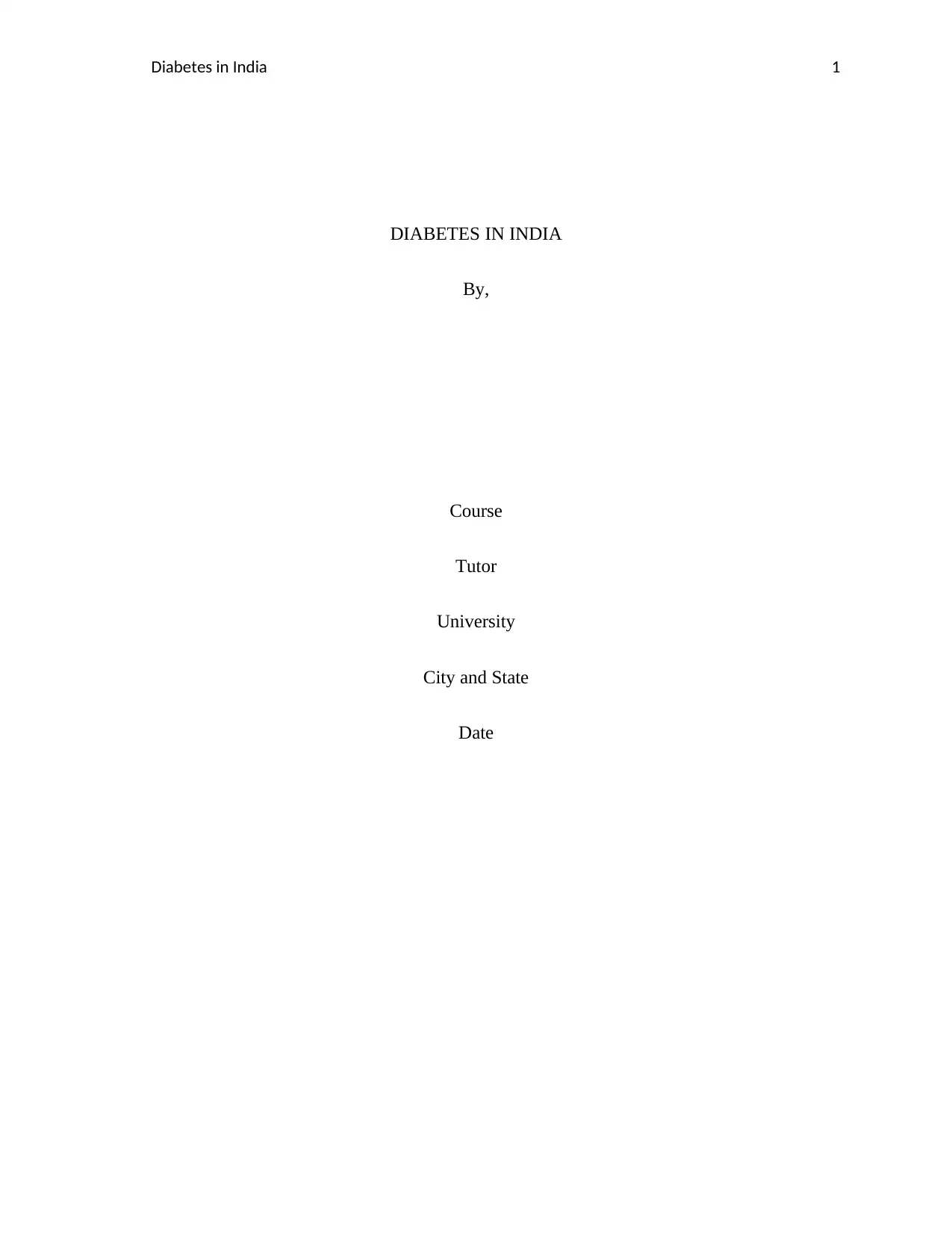
Diabetes in India 1
DIABETES IN INDIA
By,
Course
Tutor
University
City and State
Date
DIABETES IN INDIA
By,
Course
Tutor
University
City and State
Date
Paraphrase This Document
Need a fresh take? Get an instant paraphrase of this document with our AI Paraphraser
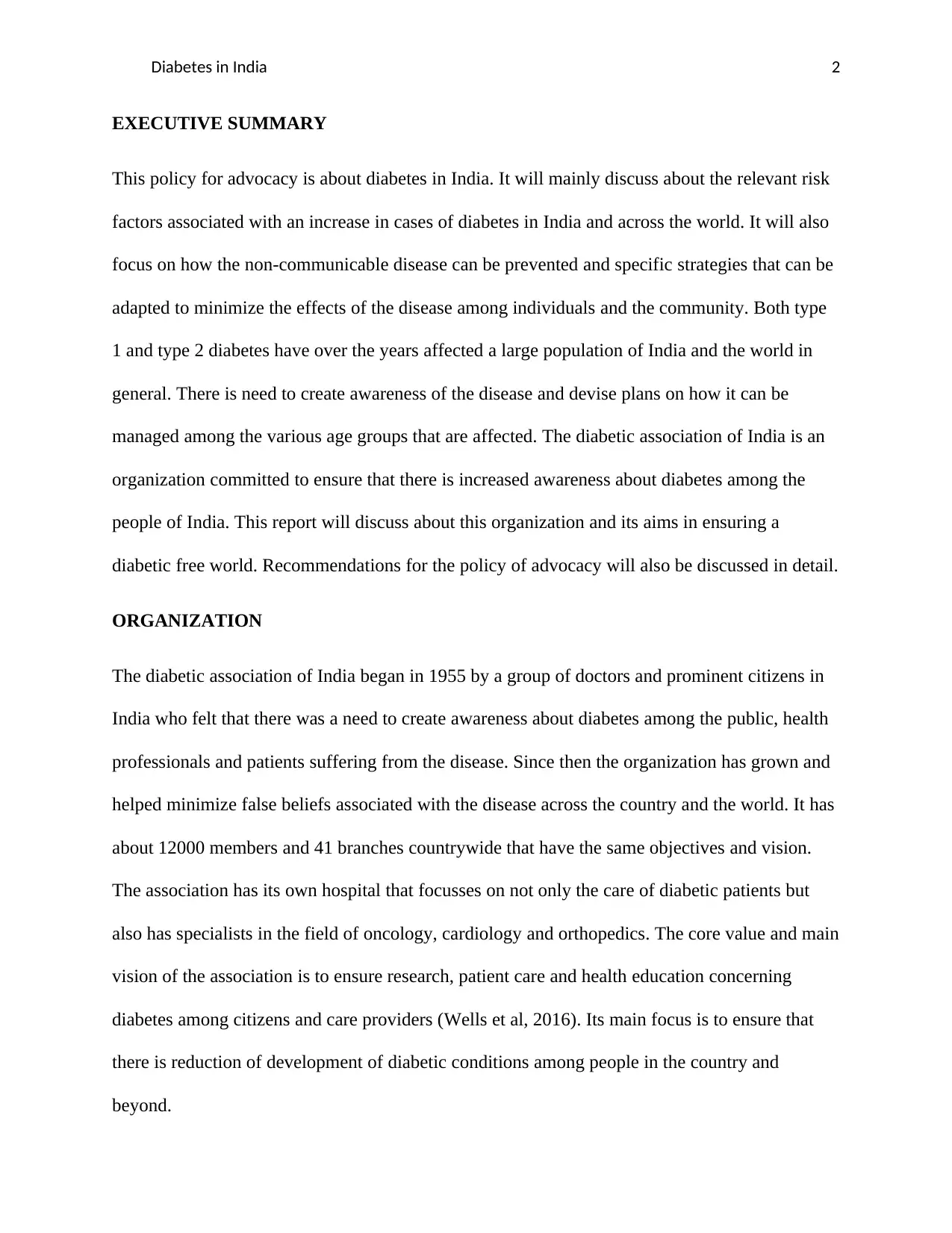
Diabetes in India 2
EXECUTIVE SUMMARY
This policy for advocacy is about diabetes in India. It will mainly discuss about the relevant risk
factors associated with an increase in cases of diabetes in India and across the world. It will also
focus on how the non-communicable disease can be prevented and specific strategies that can be
adapted to minimize the effects of the disease among individuals and the community. Both type
1 and type 2 diabetes have over the years affected a large population of India and the world in
general. There is need to create awareness of the disease and devise plans on how it can be
managed among the various age groups that are affected. The diabetic association of India is an
organization committed to ensure that there is increased awareness about diabetes among the
people of India. This report will discuss about this organization and its aims in ensuring a
diabetic free world. Recommendations for the policy of advocacy will also be discussed in detail.
ORGANIZATION
The diabetic association of India began in 1955 by a group of doctors and prominent citizens in
India who felt that there was a need to create awareness about diabetes among the public, health
professionals and patients suffering from the disease. Since then the organization has grown and
helped minimize false beliefs associated with the disease across the country and the world. It has
about 12000 members and 41 branches countrywide that have the same objectives and vision.
The association has its own hospital that focusses on not only the care of diabetic patients but
also has specialists in the field of oncology, cardiology and orthopedics. The core value and main
vision of the association is to ensure research, patient care and health education concerning
diabetes among citizens and care providers (Wells et al, 2016). Its main focus is to ensure that
there is reduction of development of diabetic conditions among people in the country and
beyond.
EXECUTIVE SUMMARY
This policy for advocacy is about diabetes in India. It will mainly discuss about the relevant risk
factors associated with an increase in cases of diabetes in India and across the world. It will also
focus on how the non-communicable disease can be prevented and specific strategies that can be
adapted to minimize the effects of the disease among individuals and the community. Both type
1 and type 2 diabetes have over the years affected a large population of India and the world in
general. There is need to create awareness of the disease and devise plans on how it can be
managed among the various age groups that are affected. The diabetic association of India is an
organization committed to ensure that there is increased awareness about diabetes among the
people of India. This report will discuss about this organization and its aims in ensuring a
diabetic free world. Recommendations for the policy of advocacy will also be discussed in detail.
ORGANIZATION
The diabetic association of India began in 1955 by a group of doctors and prominent citizens in
India who felt that there was a need to create awareness about diabetes among the public, health
professionals and patients suffering from the disease. Since then the organization has grown and
helped minimize false beliefs associated with the disease across the country and the world. It has
about 12000 members and 41 branches countrywide that have the same objectives and vision.
The association has its own hospital that focusses on not only the care of diabetic patients but
also has specialists in the field of oncology, cardiology and orthopedics. The core value and main
vision of the association is to ensure research, patient care and health education concerning
diabetes among citizens and care providers (Wells et al, 2016). Its main focus is to ensure that
there is reduction of development of diabetic conditions among people in the country and
beyond.
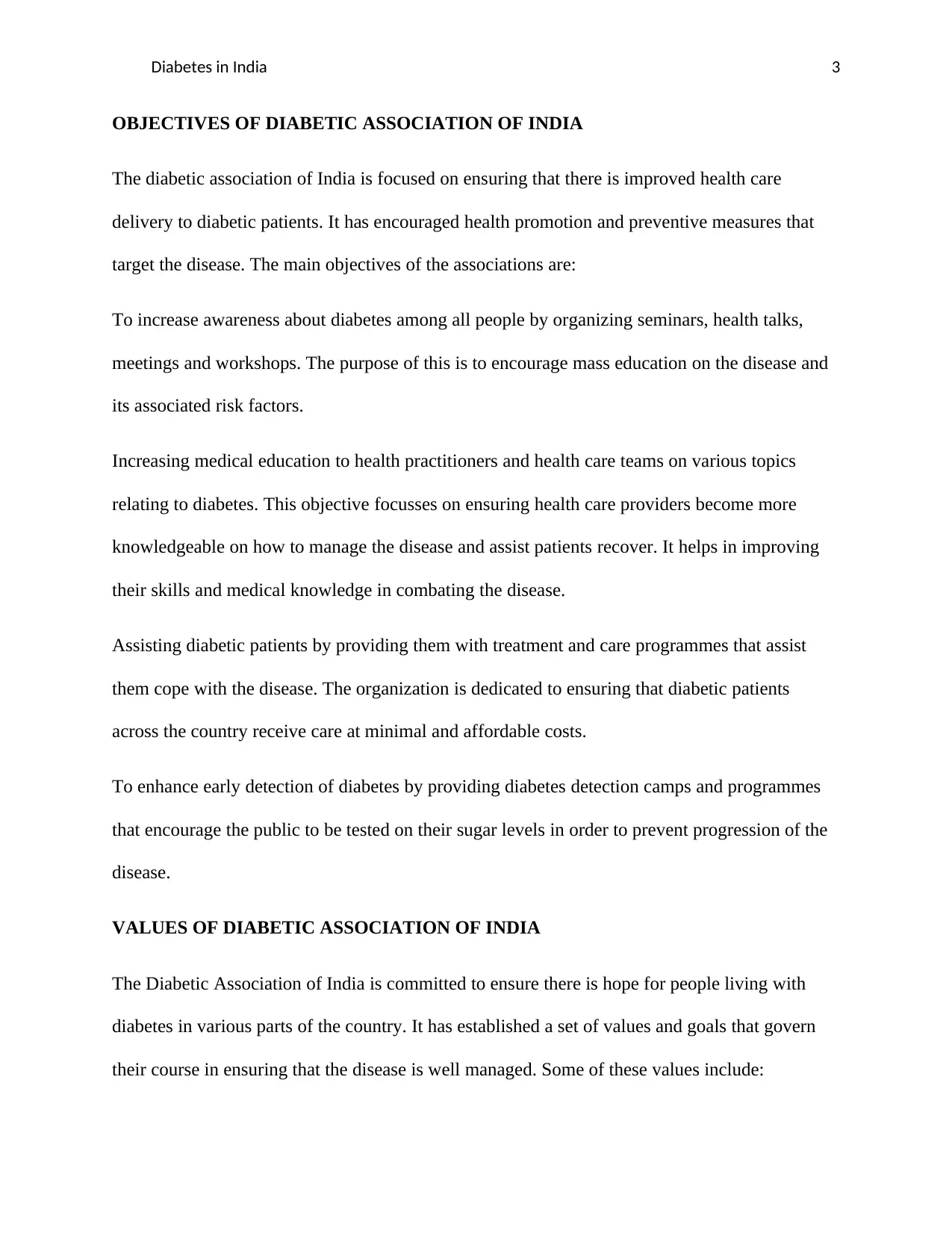
Diabetes in India 3
OBJECTIVES OF DIABETIC ASSOCIATION OF INDIA
The diabetic association of India is focused on ensuring that there is improved health care
delivery to diabetic patients. It has encouraged health promotion and preventive measures that
target the disease. The main objectives of the associations are:
To increase awareness about diabetes among all people by organizing seminars, health talks,
meetings and workshops. The purpose of this is to encourage mass education on the disease and
its associated risk factors.
Increasing medical education to health practitioners and health care teams on various topics
relating to diabetes. This objective focusses on ensuring health care providers become more
knowledgeable on how to manage the disease and assist patients recover. It helps in improving
their skills and medical knowledge in combating the disease.
Assisting diabetic patients by providing them with treatment and care programmes that assist
them cope with the disease. The organization is dedicated to ensuring that diabetic patients
across the country receive care at minimal and affordable costs.
To enhance early detection of diabetes by providing diabetes detection camps and programmes
that encourage the public to be tested on their sugar levels in order to prevent progression of the
disease.
VALUES OF DIABETIC ASSOCIATION OF INDIA
The Diabetic Association of India is committed to ensure there is hope for people living with
diabetes in various parts of the country. It has established a set of values and goals that govern
their course in ensuring that the disease is well managed. Some of these values include:
OBJECTIVES OF DIABETIC ASSOCIATION OF INDIA
The diabetic association of India is focused on ensuring that there is improved health care
delivery to diabetic patients. It has encouraged health promotion and preventive measures that
target the disease. The main objectives of the associations are:
To increase awareness about diabetes among all people by organizing seminars, health talks,
meetings and workshops. The purpose of this is to encourage mass education on the disease and
its associated risk factors.
Increasing medical education to health practitioners and health care teams on various topics
relating to diabetes. This objective focusses on ensuring health care providers become more
knowledgeable on how to manage the disease and assist patients recover. It helps in improving
their skills and medical knowledge in combating the disease.
Assisting diabetic patients by providing them with treatment and care programmes that assist
them cope with the disease. The organization is dedicated to ensuring that diabetic patients
across the country receive care at minimal and affordable costs.
To enhance early detection of diabetes by providing diabetes detection camps and programmes
that encourage the public to be tested on their sugar levels in order to prevent progression of the
disease.
VALUES OF DIABETIC ASSOCIATION OF INDIA
The Diabetic Association of India is committed to ensure there is hope for people living with
diabetes in various parts of the country. It has established a set of values and goals that govern
their course in ensuring that the disease is well managed. Some of these values include:
⊘ This is a preview!⊘
Do you want full access?
Subscribe today to unlock all pages.

Trusted by 1+ million students worldwide
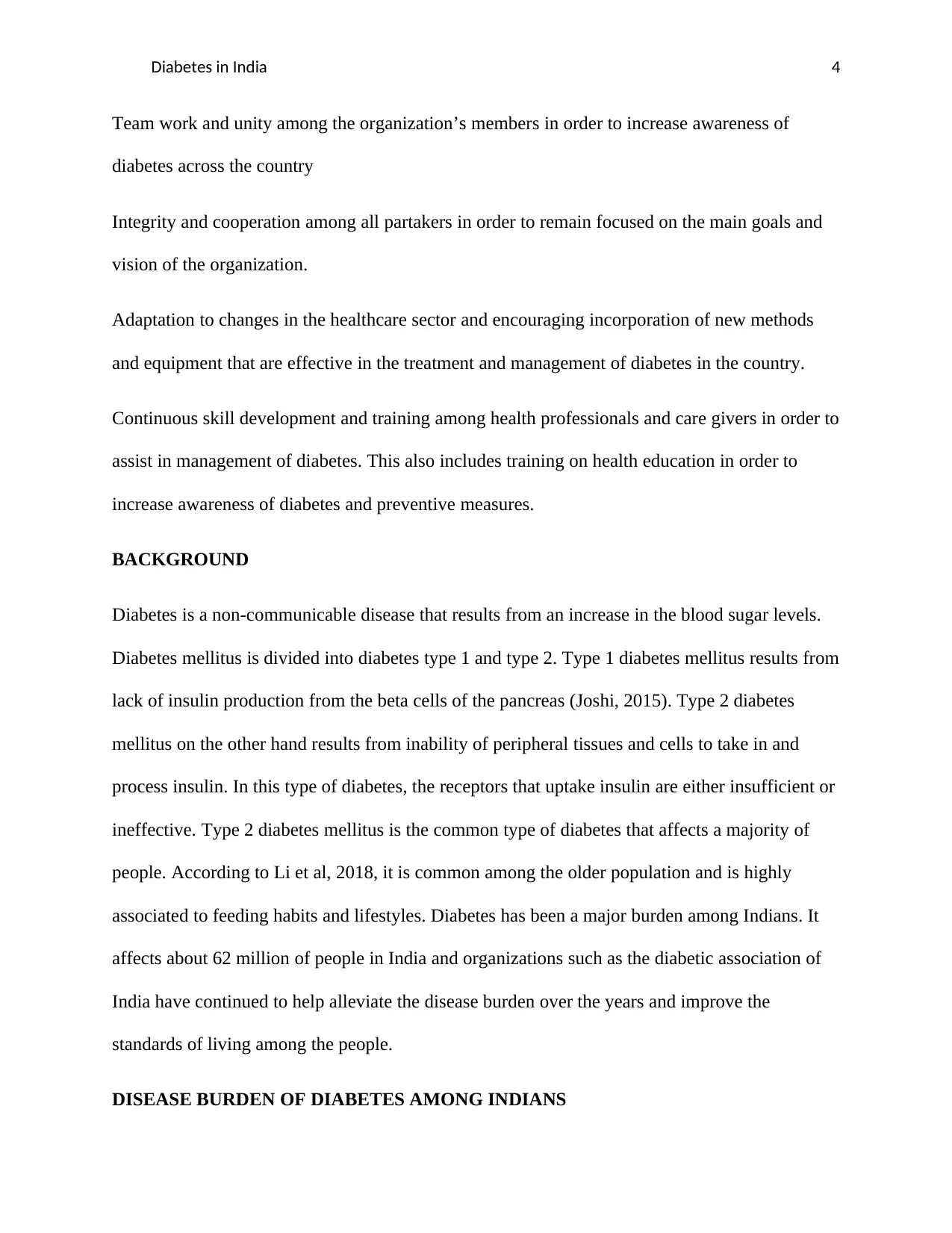
Diabetes in India 4
Team work and unity among the organization’s members in order to increase awareness of
diabetes across the country
Integrity and cooperation among all partakers in order to remain focused on the main goals and
vision of the organization.
Adaptation to changes in the healthcare sector and encouraging incorporation of new methods
and equipment that are effective in the treatment and management of diabetes in the country.
Continuous skill development and training among health professionals and care givers in order to
assist in management of diabetes. This also includes training on health education in order to
increase awareness of diabetes and preventive measures.
BACKGROUND
Diabetes is a non-communicable disease that results from an increase in the blood sugar levels.
Diabetes mellitus is divided into diabetes type 1 and type 2. Type 1 diabetes mellitus results from
lack of insulin production from the beta cells of the pancreas (Joshi, 2015). Type 2 diabetes
mellitus on the other hand results from inability of peripheral tissues and cells to take in and
process insulin. In this type of diabetes, the receptors that uptake insulin are either insufficient or
ineffective. Type 2 diabetes mellitus is the common type of diabetes that affects a majority of
people. According to Li et al, 2018, it is common among the older population and is highly
associated to feeding habits and lifestyles. Diabetes has been a major burden among Indians. It
affects about 62 million of people in India and organizations such as the diabetic association of
India have continued to help alleviate the disease burden over the years and improve the
standards of living among the people.
DISEASE BURDEN OF DIABETES AMONG INDIANS
Team work and unity among the organization’s members in order to increase awareness of
diabetes across the country
Integrity and cooperation among all partakers in order to remain focused on the main goals and
vision of the organization.
Adaptation to changes in the healthcare sector and encouraging incorporation of new methods
and equipment that are effective in the treatment and management of diabetes in the country.
Continuous skill development and training among health professionals and care givers in order to
assist in management of diabetes. This also includes training on health education in order to
increase awareness of diabetes and preventive measures.
BACKGROUND
Diabetes is a non-communicable disease that results from an increase in the blood sugar levels.
Diabetes mellitus is divided into diabetes type 1 and type 2. Type 1 diabetes mellitus results from
lack of insulin production from the beta cells of the pancreas (Joshi, 2015). Type 2 diabetes
mellitus on the other hand results from inability of peripheral tissues and cells to take in and
process insulin. In this type of diabetes, the receptors that uptake insulin are either insufficient or
ineffective. Type 2 diabetes mellitus is the common type of diabetes that affects a majority of
people. According to Li et al, 2018, it is common among the older population and is highly
associated to feeding habits and lifestyles. Diabetes has been a major burden among Indians. It
affects about 62 million of people in India and organizations such as the diabetic association of
India have continued to help alleviate the disease burden over the years and improve the
standards of living among the people.
DISEASE BURDEN OF DIABETES AMONG INDIANS
Paraphrase This Document
Need a fresh take? Get an instant paraphrase of this document with our AI Paraphraser
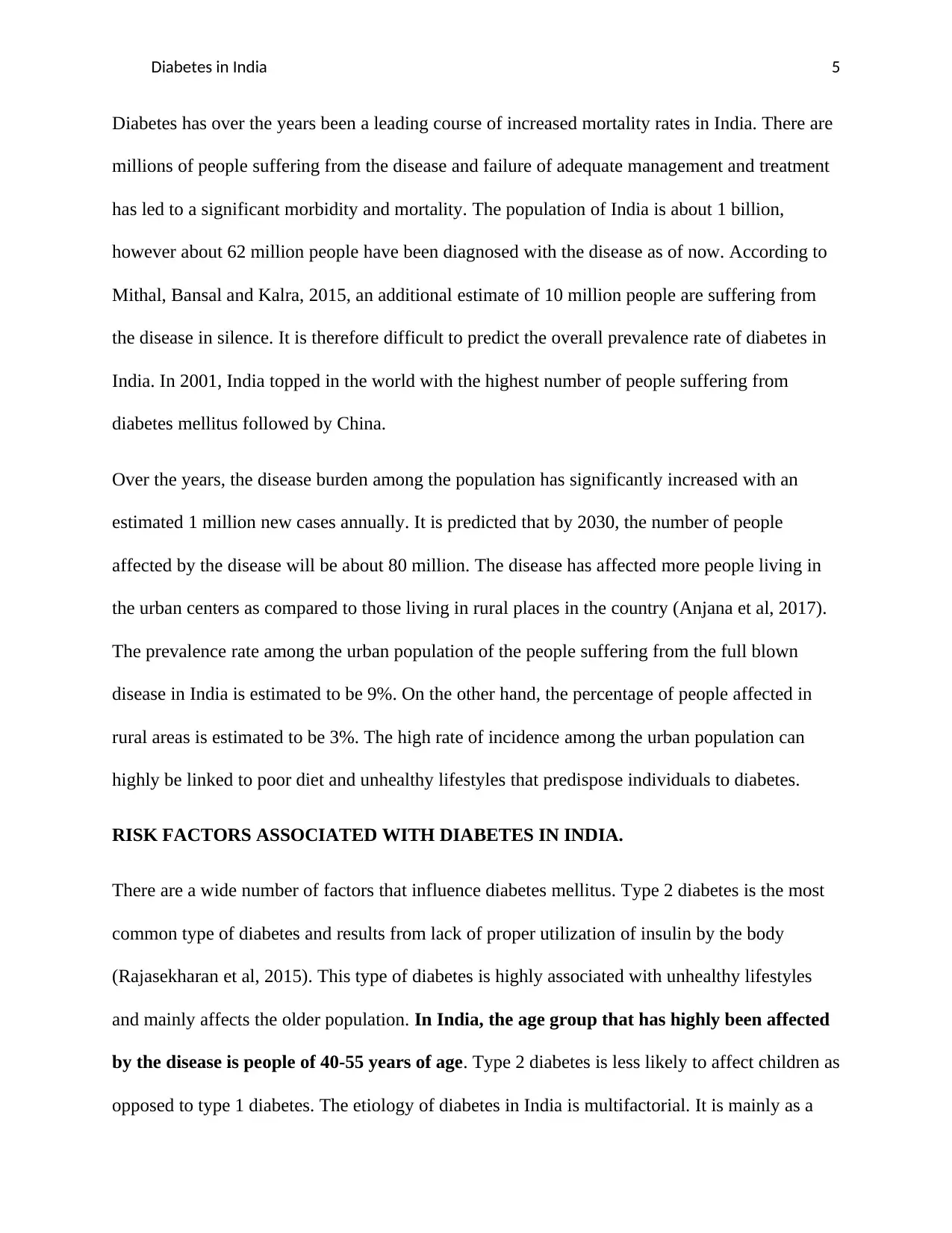
Diabetes in India 5
Diabetes has over the years been a leading course of increased mortality rates in India. There are
millions of people suffering from the disease and failure of adequate management and treatment
has led to a significant morbidity and mortality. The population of India is about 1 billion,
however about 62 million people have been diagnosed with the disease as of now. According to
Mithal, Bansal and Kalra, 2015, an additional estimate of 10 million people are suffering from
the disease in silence. It is therefore difficult to predict the overall prevalence rate of diabetes in
India. In 2001, India topped in the world with the highest number of people suffering from
diabetes mellitus followed by China.
Over the years, the disease burden among the population has significantly increased with an
estimated 1 million new cases annually. It is predicted that by 2030, the number of people
affected by the disease will be about 80 million. The disease has affected more people living in
the urban centers as compared to those living in rural places in the country (Anjana et al, 2017).
The prevalence rate among the urban population of the people suffering from the full blown
disease in India is estimated to be 9%. On the other hand, the percentage of people affected in
rural areas is estimated to be 3%. The high rate of incidence among the urban population can
highly be linked to poor diet and unhealthy lifestyles that predispose individuals to diabetes.
RISK FACTORS ASSOCIATED WITH DIABETES IN INDIA.
There are a wide number of factors that influence diabetes mellitus. Type 2 diabetes is the most
common type of diabetes and results from lack of proper utilization of insulin by the body
(Rajasekharan et al, 2015). This type of diabetes is highly associated with unhealthy lifestyles
and mainly affects the older population. In India, the age group that has highly been affected
by the disease is people of 40-55 years of age. Type 2 diabetes is less likely to affect children as
opposed to type 1 diabetes. The etiology of diabetes in India is multifactorial. It is mainly as a
Diabetes has over the years been a leading course of increased mortality rates in India. There are
millions of people suffering from the disease and failure of adequate management and treatment
has led to a significant morbidity and mortality. The population of India is about 1 billion,
however about 62 million people have been diagnosed with the disease as of now. According to
Mithal, Bansal and Kalra, 2015, an additional estimate of 10 million people are suffering from
the disease in silence. It is therefore difficult to predict the overall prevalence rate of diabetes in
India. In 2001, India topped in the world with the highest number of people suffering from
diabetes mellitus followed by China.
Over the years, the disease burden among the population has significantly increased with an
estimated 1 million new cases annually. It is predicted that by 2030, the number of people
affected by the disease will be about 80 million. The disease has affected more people living in
the urban centers as compared to those living in rural places in the country (Anjana et al, 2017).
The prevalence rate among the urban population of the people suffering from the full blown
disease in India is estimated to be 9%. On the other hand, the percentage of people affected in
rural areas is estimated to be 3%. The high rate of incidence among the urban population can
highly be linked to poor diet and unhealthy lifestyles that predispose individuals to diabetes.
RISK FACTORS ASSOCIATED WITH DIABETES IN INDIA.
There are a wide number of factors that influence diabetes mellitus. Type 2 diabetes is the most
common type of diabetes and results from lack of proper utilization of insulin by the body
(Rajasekharan et al, 2015). This type of diabetes is highly associated with unhealthy lifestyles
and mainly affects the older population. In India, the age group that has highly been affected
by the disease is people of 40-55 years of age. Type 2 diabetes is less likely to affect children as
opposed to type 1 diabetes. The etiology of diabetes in India is multifactorial. It is mainly as a
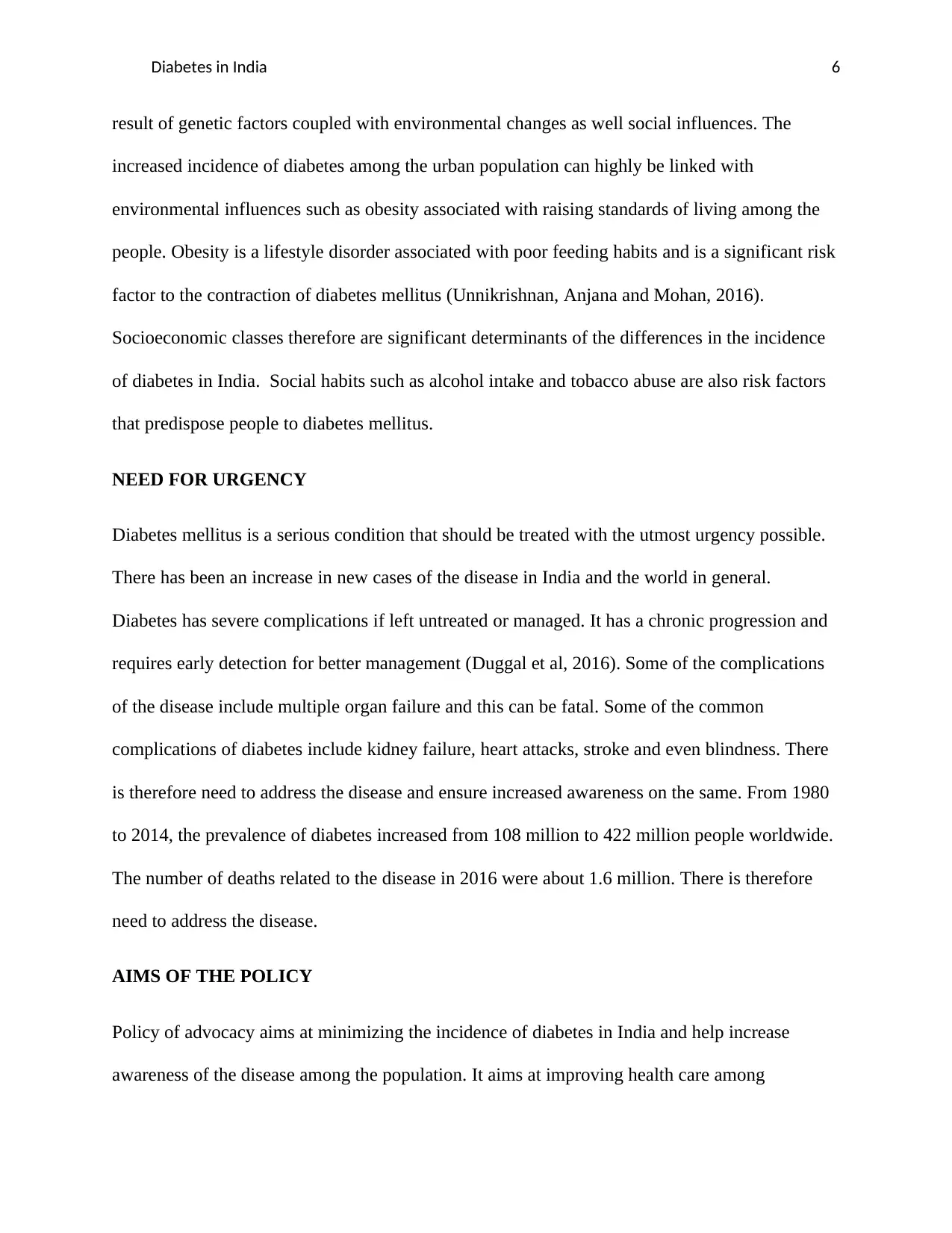
Diabetes in India 6
result of genetic factors coupled with environmental changes as well social influences. The
increased incidence of diabetes among the urban population can highly be linked with
environmental influences such as obesity associated with raising standards of living among the
people. Obesity is a lifestyle disorder associated with poor feeding habits and is a significant risk
factor to the contraction of diabetes mellitus (Unnikrishnan, Anjana and Mohan, 2016).
Socioeconomic classes therefore are significant determinants of the differences in the incidence
of diabetes in India. Social habits such as alcohol intake and tobacco abuse are also risk factors
that predispose people to diabetes mellitus.
NEED FOR URGENCY
Diabetes mellitus is a serious condition that should be treated with the utmost urgency possible.
There has been an increase in new cases of the disease in India and the world in general.
Diabetes has severe complications if left untreated or managed. It has a chronic progression and
requires early detection for better management (Duggal et al, 2016). Some of the complications
of the disease include multiple organ failure and this can be fatal. Some of the common
complications of diabetes include kidney failure, heart attacks, stroke and even blindness. There
is therefore need to address the disease and ensure increased awareness on the same. From 1980
to 2014, the prevalence of diabetes increased from 108 million to 422 million people worldwide.
The number of deaths related to the disease in 2016 were about 1.6 million. There is therefore
need to address the disease.
AIMS OF THE POLICY
Policy of advocacy aims at minimizing the incidence of diabetes in India and help increase
awareness of the disease among the population. It aims at improving health care among
result of genetic factors coupled with environmental changes as well social influences. The
increased incidence of diabetes among the urban population can highly be linked with
environmental influences such as obesity associated with raising standards of living among the
people. Obesity is a lifestyle disorder associated with poor feeding habits and is a significant risk
factor to the contraction of diabetes mellitus (Unnikrishnan, Anjana and Mohan, 2016).
Socioeconomic classes therefore are significant determinants of the differences in the incidence
of diabetes in India. Social habits such as alcohol intake and tobacco abuse are also risk factors
that predispose people to diabetes mellitus.
NEED FOR URGENCY
Diabetes mellitus is a serious condition that should be treated with the utmost urgency possible.
There has been an increase in new cases of the disease in India and the world in general.
Diabetes has severe complications if left untreated or managed. It has a chronic progression and
requires early detection for better management (Duggal et al, 2016). Some of the complications
of the disease include multiple organ failure and this can be fatal. Some of the common
complications of diabetes include kidney failure, heart attacks, stroke and even blindness. There
is therefore need to address the disease and ensure increased awareness on the same. From 1980
to 2014, the prevalence of diabetes increased from 108 million to 422 million people worldwide.
The number of deaths related to the disease in 2016 were about 1.6 million. There is therefore
need to address the disease.
AIMS OF THE POLICY
Policy of advocacy aims at minimizing the incidence of diabetes in India and help increase
awareness of the disease among the population. It aims at improving health care among
⊘ This is a preview!⊘
Do you want full access?
Subscribe today to unlock all pages.

Trusted by 1+ million students worldwide
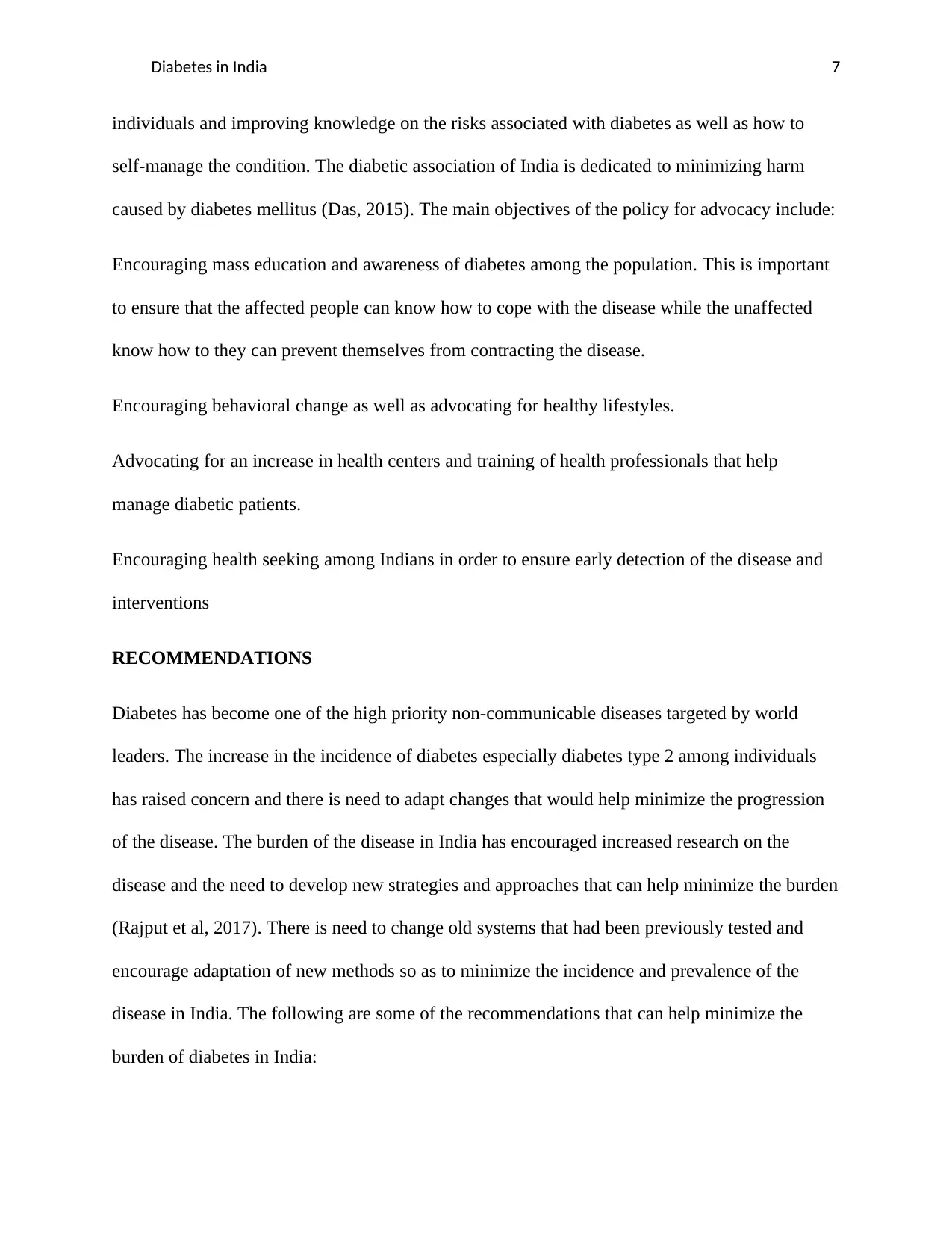
Diabetes in India 7
individuals and improving knowledge on the risks associated with diabetes as well as how to
self-manage the condition. The diabetic association of India is dedicated to minimizing harm
caused by diabetes mellitus (Das, 2015). The main objectives of the policy for advocacy include:
Encouraging mass education and awareness of diabetes among the population. This is important
to ensure that the affected people can know how to cope with the disease while the unaffected
know how to they can prevent themselves from contracting the disease.
Encouraging behavioral change as well as advocating for healthy lifestyles.
Advocating for an increase in health centers and training of health professionals that help
manage diabetic patients.
Encouraging health seeking among Indians in order to ensure early detection of the disease and
interventions
RECOMMENDATIONS
Diabetes has become one of the high priority non-communicable diseases targeted by world
leaders. The increase in the incidence of diabetes especially diabetes type 2 among individuals
has raised concern and there is need to adapt changes that would help minimize the progression
of the disease. The burden of the disease in India has encouraged increased research on the
disease and the need to develop new strategies and approaches that can help minimize the burden
(Rajput et al, 2017). There is need to change old systems that had been previously tested and
encourage adaptation of new methods so as to minimize the incidence and prevalence of the
disease in India. The following are some of the recommendations that can help minimize the
burden of diabetes in India:
individuals and improving knowledge on the risks associated with diabetes as well as how to
self-manage the condition. The diabetic association of India is dedicated to minimizing harm
caused by diabetes mellitus (Das, 2015). The main objectives of the policy for advocacy include:
Encouraging mass education and awareness of diabetes among the population. This is important
to ensure that the affected people can know how to cope with the disease while the unaffected
know how to they can prevent themselves from contracting the disease.
Encouraging behavioral change as well as advocating for healthy lifestyles.
Advocating for an increase in health centers and training of health professionals that help
manage diabetic patients.
Encouraging health seeking among Indians in order to ensure early detection of the disease and
interventions
RECOMMENDATIONS
Diabetes has become one of the high priority non-communicable diseases targeted by world
leaders. The increase in the incidence of diabetes especially diabetes type 2 among individuals
has raised concern and there is need to adapt changes that would help minimize the progression
of the disease. The burden of the disease in India has encouraged increased research on the
disease and the need to develop new strategies and approaches that can help minimize the burden
(Rajput et al, 2017). There is need to change old systems that had been previously tested and
encourage adaptation of new methods so as to minimize the incidence and prevalence of the
disease in India. The following are some of the recommendations that can help minimize the
burden of diabetes in India:
Paraphrase This Document
Need a fresh take? Get an instant paraphrase of this document with our AI Paraphraser
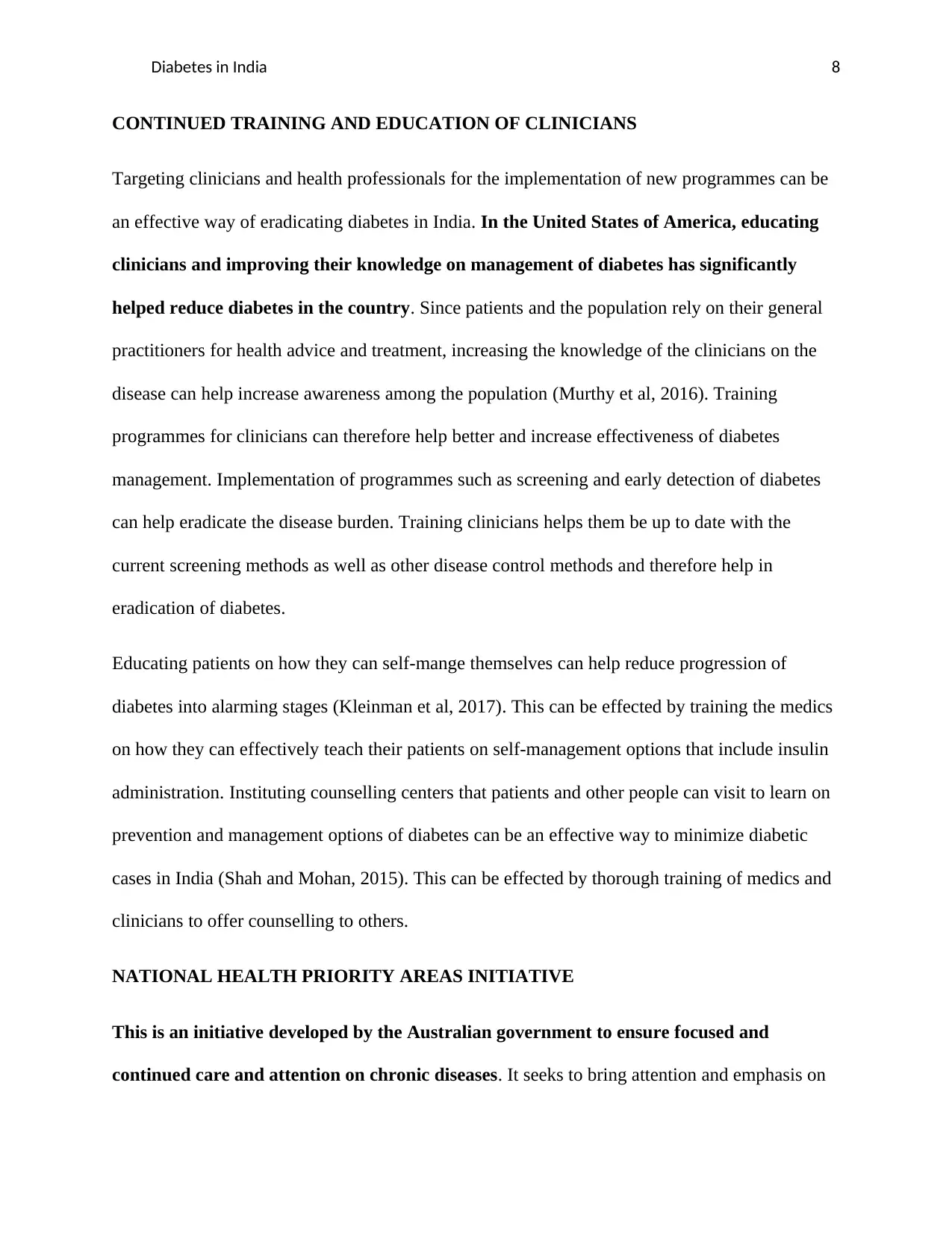
Diabetes in India 8
CONTINUED TRAINING AND EDUCATION OF CLINICIANS
Targeting clinicians and health professionals for the implementation of new programmes can be
an effective way of eradicating diabetes in India. In the United States of America, educating
clinicians and improving their knowledge on management of diabetes has significantly
helped reduce diabetes in the country. Since patients and the population rely on their general
practitioners for health advice and treatment, increasing the knowledge of the clinicians on the
disease can help increase awareness among the population (Murthy et al, 2016). Training
programmes for clinicians can therefore help better and increase effectiveness of diabetes
management. Implementation of programmes such as screening and early detection of diabetes
can help eradicate the disease burden. Training clinicians helps them be up to date with the
current screening methods as well as other disease control methods and therefore help in
eradication of diabetes.
Educating patients on how they can self-mange themselves can help reduce progression of
diabetes into alarming stages (Kleinman et al, 2017). This can be effected by training the medics
on how they can effectively teach their patients on self-management options that include insulin
administration. Instituting counselling centers that patients and other people can visit to learn on
prevention and management options of diabetes can be an effective way to minimize diabetic
cases in India (Shah and Mohan, 2015). This can be effected by thorough training of medics and
clinicians to offer counselling to others.
NATIONAL HEALTH PRIORITY AREAS INITIATIVE
This is an initiative developed by the Australian government to ensure focused and
continued care and attention on chronic diseases. It seeks to bring attention and emphasis on
CONTINUED TRAINING AND EDUCATION OF CLINICIANS
Targeting clinicians and health professionals for the implementation of new programmes can be
an effective way of eradicating diabetes in India. In the United States of America, educating
clinicians and improving their knowledge on management of diabetes has significantly
helped reduce diabetes in the country. Since patients and the population rely on their general
practitioners for health advice and treatment, increasing the knowledge of the clinicians on the
disease can help increase awareness among the population (Murthy et al, 2016). Training
programmes for clinicians can therefore help better and increase effectiveness of diabetes
management. Implementation of programmes such as screening and early detection of diabetes
can help eradicate the disease burden. Training clinicians helps them be up to date with the
current screening methods as well as other disease control methods and therefore help in
eradication of diabetes.
Educating patients on how they can self-mange themselves can help reduce progression of
diabetes into alarming stages (Kleinman et al, 2017). This can be effected by training the medics
on how they can effectively teach their patients on self-management options that include insulin
administration. Instituting counselling centers that patients and other people can visit to learn on
prevention and management options of diabetes can be an effective way to minimize diabetic
cases in India (Shah and Mohan, 2015). This can be effected by thorough training of medics and
clinicians to offer counselling to others.
NATIONAL HEALTH PRIORITY AREAS INITIATIVE
This is an initiative developed by the Australian government to ensure focused and
continued care and attention on chronic diseases. It seeks to bring attention and emphasis on
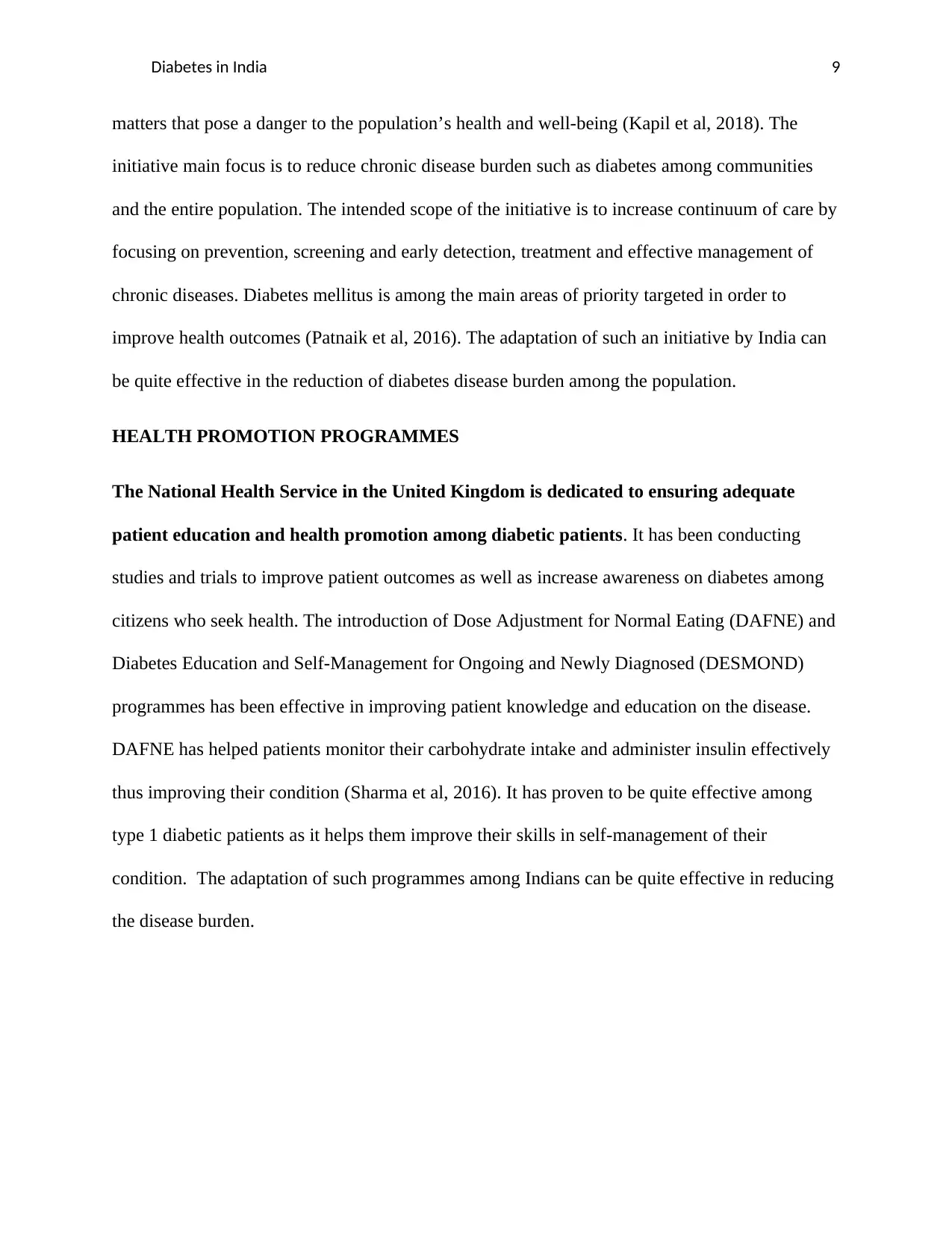
Diabetes in India 9
matters that pose a danger to the population’s health and well-being (Kapil et al, 2018). The
initiative main focus is to reduce chronic disease burden such as diabetes among communities
and the entire population. The intended scope of the initiative is to increase continuum of care by
focusing on prevention, screening and early detection, treatment and effective management of
chronic diseases. Diabetes mellitus is among the main areas of priority targeted in order to
improve health outcomes (Patnaik et al, 2016). The adaptation of such an initiative by India can
be quite effective in the reduction of diabetes disease burden among the population.
HEALTH PROMOTION PROGRAMMES
The National Health Service in the United Kingdom is dedicated to ensuring adequate
patient education and health promotion among diabetic patients. It has been conducting
studies and trials to improve patient outcomes as well as increase awareness on diabetes among
citizens who seek health. The introduction of Dose Adjustment for Normal Eating (DAFNE) and
Diabetes Education and Self-Management for Ongoing and Newly Diagnosed (DESMOND)
programmes has been effective in improving patient knowledge and education on the disease.
DAFNE has helped patients monitor their carbohydrate intake and administer insulin effectively
thus improving their condition (Sharma et al, 2016). It has proven to be quite effective among
type 1 diabetic patients as it helps them improve their skills in self-management of their
condition. The adaptation of such programmes among Indians can be quite effective in reducing
the disease burden.
matters that pose a danger to the population’s health and well-being (Kapil et al, 2018). The
initiative main focus is to reduce chronic disease burden such as diabetes among communities
and the entire population. The intended scope of the initiative is to increase continuum of care by
focusing on prevention, screening and early detection, treatment and effective management of
chronic diseases. Diabetes mellitus is among the main areas of priority targeted in order to
improve health outcomes (Patnaik et al, 2016). The adaptation of such an initiative by India can
be quite effective in the reduction of diabetes disease burden among the population.
HEALTH PROMOTION PROGRAMMES
The National Health Service in the United Kingdom is dedicated to ensuring adequate
patient education and health promotion among diabetic patients. It has been conducting
studies and trials to improve patient outcomes as well as increase awareness on diabetes among
citizens who seek health. The introduction of Dose Adjustment for Normal Eating (DAFNE) and
Diabetes Education and Self-Management for Ongoing and Newly Diagnosed (DESMOND)
programmes has been effective in improving patient knowledge and education on the disease.
DAFNE has helped patients monitor their carbohydrate intake and administer insulin effectively
thus improving their condition (Sharma et al, 2016). It has proven to be quite effective among
type 1 diabetic patients as it helps them improve their skills in self-management of their
condition. The adaptation of such programmes among Indians can be quite effective in reducing
the disease burden.
⊘ This is a preview!⊘
Do you want full access?
Subscribe today to unlock all pages.

Trusted by 1+ million students worldwide
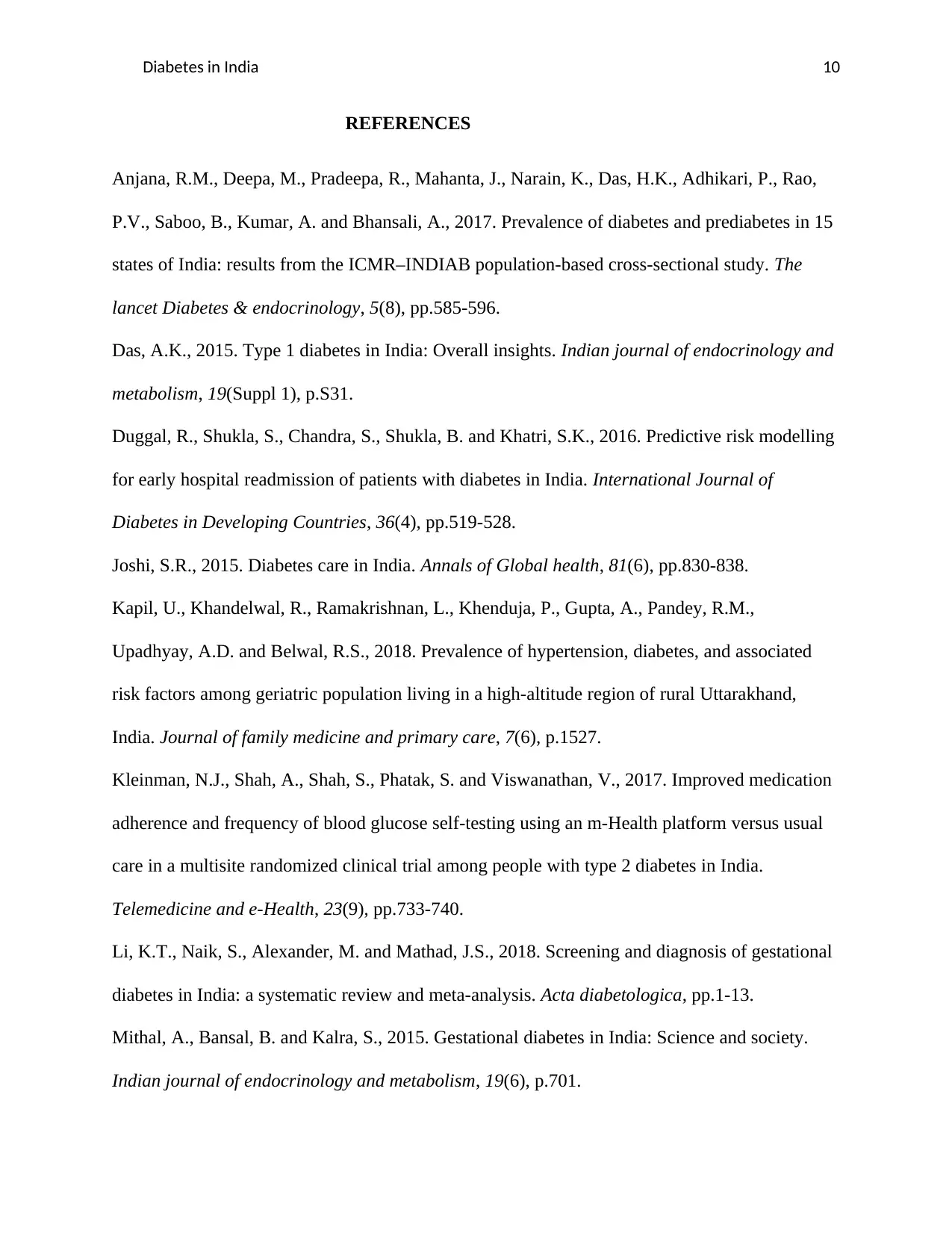
Diabetes in India 10
REFERENCES
Anjana, R.M., Deepa, M., Pradeepa, R., Mahanta, J., Narain, K., Das, H.K., Adhikari, P., Rao,
P.V., Saboo, B., Kumar, A. and Bhansali, A., 2017. Prevalence of diabetes and prediabetes in 15
states of India: results from the ICMR–INDIAB population-based cross-sectional study. The
lancet Diabetes & endocrinology, 5(8), pp.585-596.
Das, A.K., 2015. Type 1 diabetes in India: Overall insights. Indian journal of endocrinology and
metabolism, 19(Suppl 1), p.S31.
Duggal, R., Shukla, S., Chandra, S., Shukla, B. and Khatri, S.K., 2016. Predictive risk modelling
for early hospital readmission of patients with diabetes in India. International Journal of
Diabetes in Developing Countries, 36(4), pp.519-528.
Joshi, S.R., 2015. Diabetes care in India. Annals of Global health, 81(6), pp.830-838.
Kapil, U., Khandelwal, R., Ramakrishnan, L., Khenduja, P., Gupta, A., Pandey, R.M.,
Upadhyay, A.D. and Belwal, R.S., 2018. Prevalence of hypertension, diabetes, and associated
risk factors among geriatric population living in a high-altitude region of rural Uttarakhand,
India. Journal of family medicine and primary care, 7(6), p.1527.
Kleinman, N.J., Shah, A., Shah, S., Phatak, S. and Viswanathan, V., 2017. Improved medication
adherence and frequency of blood glucose self-testing using an m-Health platform versus usual
care in a multisite randomized clinical trial among people with type 2 diabetes in India.
Telemedicine and e-Health, 23(9), pp.733-740.
Li, K.T., Naik, S., Alexander, M. and Mathad, J.S., 2018. Screening and diagnosis of gestational
diabetes in India: a systematic review and meta-analysis. Acta diabetologica, pp.1-13.
Mithal, A., Bansal, B. and Kalra, S., 2015. Gestational diabetes in India: Science and society.
Indian journal of endocrinology and metabolism, 19(6), p.701.
REFERENCES
Anjana, R.M., Deepa, M., Pradeepa, R., Mahanta, J., Narain, K., Das, H.K., Adhikari, P., Rao,
P.V., Saboo, B., Kumar, A. and Bhansali, A., 2017. Prevalence of diabetes and prediabetes in 15
states of India: results from the ICMR–INDIAB population-based cross-sectional study. The
lancet Diabetes & endocrinology, 5(8), pp.585-596.
Das, A.K., 2015. Type 1 diabetes in India: Overall insights. Indian journal of endocrinology and
metabolism, 19(Suppl 1), p.S31.
Duggal, R., Shukla, S., Chandra, S., Shukla, B. and Khatri, S.K., 2016. Predictive risk modelling
for early hospital readmission of patients with diabetes in India. International Journal of
Diabetes in Developing Countries, 36(4), pp.519-528.
Joshi, S.R., 2015. Diabetes care in India. Annals of Global health, 81(6), pp.830-838.
Kapil, U., Khandelwal, R., Ramakrishnan, L., Khenduja, P., Gupta, A., Pandey, R.M.,
Upadhyay, A.D. and Belwal, R.S., 2018. Prevalence of hypertension, diabetes, and associated
risk factors among geriatric population living in a high-altitude region of rural Uttarakhand,
India. Journal of family medicine and primary care, 7(6), p.1527.
Kleinman, N.J., Shah, A., Shah, S., Phatak, S. and Viswanathan, V., 2017. Improved medication
adherence and frequency of blood glucose self-testing using an m-Health platform versus usual
care in a multisite randomized clinical trial among people with type 2 diabetes in India.
Telemedicine and e-Health, 23(9), pp.733-740.
Li, K.T., Naik, S., Alexander, M. and Mathad, J.S., 2018. Screening and diagnosis of gestational
diabetes in India: a systematic review and meta-analysis. Acta diabetologica, pp.1-13.
Mithal, A., Bansal, B. and Kalra, S., 2015. Gestational diabetes in India: Science and society.
Indian journal of endocrinology and metabolism, 19(6), p.701.
Paraphrase This Document
Need a fresh take? Get an instant paraphrase of this document with our AI Paraphraser
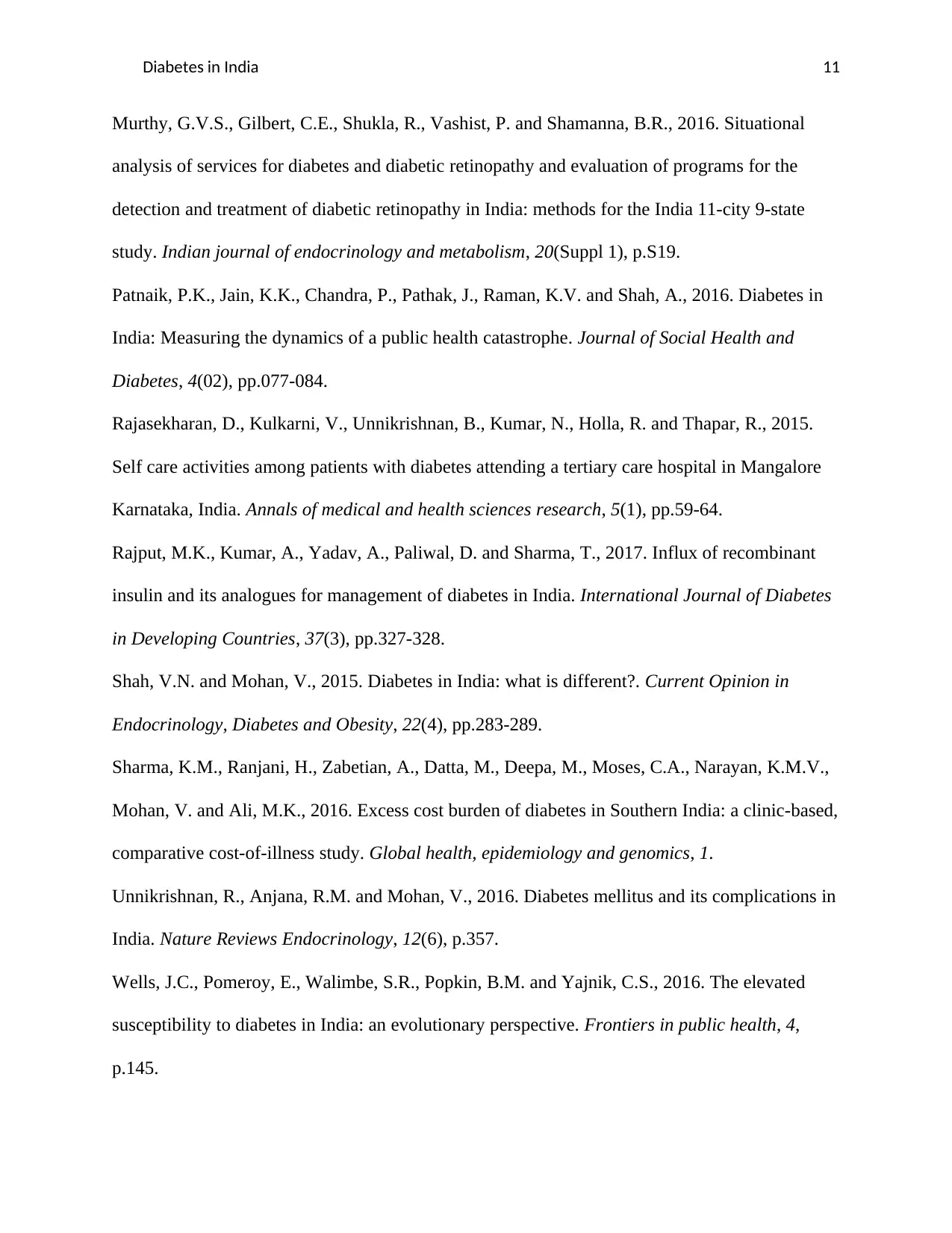
Diabetes in India 11
Murthy, G.V.S., Gilbert, C.E., Shukla, R., Vashist, P. and Shamanna, B.R., 2016. Situational
analysis of services for diabetes and diabetic retinopathy and evaluation of programs for the
detection and treatment of diabetic retinopathy in India: methods for the India 11-city 9-state
study. Indian journal of endocrinology and metabolism, 20(Suppl 1), p.S19.
Patnaik, P.K., Jain, K.K., Chandra, P., Pathak, J., Raman, K.V. and Shah, A., 2016. Diabetes in
India: Measuring the dynamics of a public health catastrophe. Journal of Social Health and
Diabetes, 4(02), pp.077-084.
Rajasekharan, D., Kulkarni, V., Unnikrishnan, B., Kumar, N., Holla, R. and Thapar, R., 2015.
Self care activities among patients with diabetes attending a tertiary care hospital in Mangalore
Karnataka, India. Annals of medical and health sciences research, 5(1), pp.59-64.
Rajput, M.K., Kumar, A., Yadav, A., Paliwal, D. and Sharma, T., 2017. Influx of recombinant
insulin and its analogues for management of diabetes in India. International Journal of Diabetes
in Developing Countries, 37(3), pp.327-328.
Shah, V.N. and Mohan, V., 2015. Diabetes in India: what is different?. Current Opinion in
Endocrinology, Diabetes and Obesity, 22(4), pp.283-289.
Sharma, K.M., Ranjani, H., Zabetian, A., Datta, M., Deepa, M., Moses, C.A., Narayan, K.M.V.,
Mohan, V. and Ali, M.K., 2016. Excess cost burden of diabetes in Southern India: a clinic-based,
comparative cost-of-illness study. Global health, epidemiology and genomics, 1.
Unnikrishnan, R., Anjana, R.M. and Mohan, V., 2016. Diabetes mellitus and its complications in
India. Nature Reviews Endocrinology, 12(6), p.357.
Wells, J.C., Pomeroy, E., Walimbe, S.R., Popkin, B.M. and Yajnik, C.S., 2016. The elevated
susceptibility to diabetes in India: an evolutionary perspective. Frontiers in public health, 4,
p.145.
Murthy, G.V.S., Gilbert, C.E., Shukla, R., Vashist, P. and Shamanna, B.R., 2016. Situational
analysis of services for diabetes and diabetic retinopathy and evaluation of programs for the
detection and treatment of diabetic retinopathy in India: methods for the India 11-city 9-state
study. Indian journal of endocrinology and metabolism, 20(Suppl 1), p.S19.
Patnaik, P.K., Jain, K.K., Chandra, P., Pathak, J., Raman, K.V. and Shah, A., 2016. Diabetes in
India: Measuring the dynamics of a public health catastrophe. Journal of Social Health and
Diabetes, 4(02), pp.077-084.
Rajasekharan, D., Kulkarni, V., Unnikrishnan, B., Kumar, N., Holla, R. and Thapar, R., 2015.
Self care activities among patients with diabetes attending a tertiary care hospital in Mangalore
Karnataka, India. Annals of medical and health sciences research, 5(1), pp.59-64.
Rajput, M.K., Kumar, A., Yadav, A., Paliwal, D. and Sharma, T., 2017. Influx of recombinant
insulin and its analogues for management of diabetes in India. International Journal of Diabetes
in Developing Countries, 37(3), pp.327-328.
Shah, V.N. and Mohan, V., 2015. Diabetes in India: what is different?. Current Opinion in
Endocrinology, Diabetes and Obesity, 22(4), pp.283-289.
Sharma, K.M., Ranjani, H., Zabetian, A., Datta, M., Deepa, M., Moses, C.A., Narayan, K.M.V.,
Mohan, V. and Ali, M.K., 2016. Excess cost burden of diabetes in Southern India: a clinic-based,
comparative cost-of-illness study. Global health, epidemiology and genomics, 1.
Unnikrishnan, R., Anjana, R.M. and Mohan, V., 2016. Diabetes mellitus and its complications in
India. Nature Reviews Endocrinology, 12(6), p.357.
Wells, J.C., Pomeroy, E., Walimbe, S.R., Popkin, B.M. and Yajnik, C.S., 2016. The elevated
susceptibility to diabetes in India: an evolutionary perspective. Frontiers in public health, 4,
p.145.

Diabetes in India 12
⊘ This is a preview!⊘
Do you want full access?
Subscribe today to unlock all pages.

Trusted by 1+ million students worldwide
1 out of 12
Related Documents
Your All-in-One AI-Powered Toolkit for Academic Success.
+13062052269
info@desklib.com
Available 24*7 on WhatsApp / Email
![[object Object]](/_next/static/media/star-bottom.7253800d.svg)
Unlock your academic potential
Copyright © 2020–2025 A2Z Services. All Rights Reserved. Developed and managed by ZUCOL.





